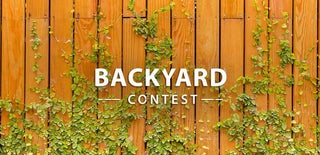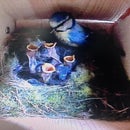Introduction: Quick & Cheap Outdoor Water Tray for Kids
Sun's Out, Fun's Out!
I still have some pallets left over from when I was making a Pallet Sand Pit, so I was feeling on a roll, re-constructing some of the play items from my son's daycare (during COVID)....I was pleased that it turned out so well, and means we can spend more time out in the backyard! (Seemed a good time to publish - please vote if you like it!)
I think the clever hack is to use thick plastic sheet to make the whole thing waterproof. Although this is not as durable as buying a proper solid-moulded plastic one, it's certainly cheap, and will certainly last the summer, whereby I can either put new plastic on it next year, or just use it dry as a raised Sand Pit...we shall see :o)
I also found a way to hack a drainage hole in it, using a wire terminal, if you're feeling geeky - again this is a $1/£1 hack, and works well.
I'm sure it's obvious, but I like this as I could use it for slime, handling mud, snails, etc. - and if we had a dog, I'd wager it'd be useful for cleaning also! The more I think about it - the more this is more than just a Water Tray, but for now, my son gets first go with it! For now...
Safety. I hate to raise this point - but feel I have to, as drowning is one of the highest causes of death of kids in the developed world. So forgive the downer, but please always remember to supervise your kids around water. With that said, not that this negates the need to supervise, but the main reason I *raised* the water tray was to hopefully avoid any such accident by making it harder to fall in / lay in water. Consequently, I personally would not recommend omitting the legs/stand if you do make this, if at all possible. Apart from that, it means my back thanks me for less bending over! So, a good move all round. Stay safe and have fun =)
Supplies
I think the changes are if you're reading this, you probably are quite handy and have the tools. But for completeness of the I'ble - here are some links...
I used a Circular Saw, but even a rip/hand saw will do. Nothing complex, just a couple cuts. https://amzn.to/2WbYM9e
I also used a Drill and Driver for screwing together. https://amzn.to/3cd62Hj
I've mentioned in the Sand Pit I'ble, that using a thicker Barn Paint saves a lot of sanding down, as it essentially 'glues down' the potential splinters. Not a 100% guarantee, but so far so good. Available in many colours from Bedec: https://amzn.to/35CU87r
The plastic sheet is 250micron, but 'thick plastic' will get you there. https://amzn.to/3bdOqdk
Staple Gun will come in hand also: https://amzn.to/3fvvvhu
I suspect you have screws, but I'd recommend a 'multi pack', as of course wood thickness and the type of job varies hugely, so having options is good: https://amzn.to/3b8C9H7
Step 1: Choose Your Pallet
As mentioned in a previous guide to make a Pallet Sand Pit: https://www.instructables.com/id/Pallet-Sand-Pit-D...
I try to not recommend an exact dimensions to work from my plans. This is more about being resourceful with what you have.
I was lucky to have a pallet which had ~1/4in / 7mm thick rough ply on it. I stripped off the wood, by using a crowbar and hammer. I'm not going to give a detailed guide on 'how to dismantle a pallet' as there are literally 100s of videos out there, but this one was good for me! (LINK)
The key thing here was to cut the board in half - this was I was left with both a 'tray base' and a 'lid' to go on top afterward. It ended up being about 600x900mm, which seems fine given my 4 year old can only reach about 300-400mm anyway, so one need not go crazy and make it huge.
NOTE: As mentioned in the guide above, please do check your pallet is HT, and not MB on the side. More info here: https://www.1001pallets.com/pallet-safety/
Step 2: Lay Out
I used some slightly thicker (~18mm / 3/4in) planks for the sides. As you can see I did a little plan (as much for my son) to work ahead, but it helps me to plan the following steps and not forget a key part.
I also got my son to 'knock-off' any large chips of wood that might be splintery, with a trowel. I'm sure you could use a sander if you wanted, but this was all done in a couple hours, so it's about how much perfection you want and how accident prone your think your kid(s) might be. You know best ;o)
Step 3: Pilot Holes Like a Pro
When assembling things with screws, it can be tempting to skip this step to pre-drill a smaller hole for the screws to go. As you are screwing the very edge of the wood, and then going into the end of a thin plank, I think it's worth the effort personally.
Good habits start young ;o)
Step 4: Fix Base
Nothing complicated, just small ~1inch screws to fix the base down to the frame.
It seems like Cats in Shoeboxes, kids work the same...allow time for this step.
Step 5: Ergonomics
Fancy terms, for 'what height is right?'
I think the best way was to get my son to hold a plank at a height which looked comfortable. I then took a measurement of a thicker piece of wood, and cut 4 similar 'legs'. As a note, I used hardwood, as of course the wood will likely be sitting in water (spilled), so the better you can use, that will help. But softwood will be fine also - but perhaps add extra wood stain/paint.
Step 6: Leg Blocks
There are many ways to attach legs to tables. This is not the most beautify, but utilises the 'chunks' of wood you get in pallets nicely. As shown.
I took a note of the offset of the leg wood, and then screwed through the 'tray' into the blocks. I did 3 screws for each, but 2 would do to be honest.
Jump on for testing. Optional.
Step 7: Attach Legs
The legs were hardwood, so although I was not worried about splitting, the screws simply go in easier if you pilot the holes first. 3 per leg recommended. As a rule, if I can have a screw which is twice the thickness of the element I'm trying to secure, that's a good measure if unsure. But a lot of it is 'by eye' I must confess.
Step 8: Cross Brace
I would recommend cross bracing with small pieces of wooden plank. It's not critical, but will significantly increase the longevity of the project. The water will be deceptively heavy once filled, so it will add stability.
I suspect the one on the middle, underneath the tray is a bit 'over-engineered', but if you have very flimsy wood, perhaps consider it. I just wanted to use up the scrap wood tbh!
Step 9: Round Edges
Assuming kids will be kids, and slip could mean they hit their head on the corner of the tray/table. So best to just round off those edges. I used a plane, but frankly a saw, knife, rasp, etc. will do - even bashing it with a hammer is better than nothing.
Step 10: Paint
I actually used wood stain on the underside, as it was not going to get the contact of the 'Tray', which I did on the 'special' Barn Paint. I'd recommend gloves and goggles. I also did a small video to give some tips on this and other great ways to get your kids doing DIY, but still be safe.
Step 11: Waterproofing
I cut a section of plastic from a roll, and left it doubled over - to be 2-ply for durability, but in hindsight 1-ply would be fine, and arguably easier to fold!
I used some bricks to hold down evenly. Folded the corners as carefully as I could, but it'd find as the water kinda 'smooths' things out for you. I'm no perfectionist, and my son is impatient to get going!
Use the staple-gun to secure as shown. I'd recommend folding over the rim a long way, as shown, as this simply is a nicer (splinter free) surface to lean on.
Step 12: Optional: Lid
Unlike the sandpit I made which really needs a lid (or you'll get kitty poop in it!), this lid is more a question of stopping leaves and other debris building up, but hardly essential, as you just wash it down after an unused spell.
I had some leftover 'rubble sacks' from a building project, so used these to cover the wood to keep rain off. It also doubles as a small table when not in use, so is quote handy to have.
Step 13: Level & Fill
Slight exaggeration with Spirit Level, as it'll be clear with the water in it how well you're doing! So crack on a fill it up!
Step 14: All In!
It seems pretty much everything has go into the water now. It's been great fun =)
Step 15: Optional: Drainage
I used a Wiring Gland (LINK) as a way to a. clamp the plastic sheet down, and b. allow water to drain. It was the cheapest thing I could think of which allowed a good seal between the plastic and the wood. I'd say the appeal was more that my son enjoyed draining it at the end of a day and watering the garden with the water.
To do this, drill a hole through the plastic and the wood. I'd suggest vacuuming any small debris out, or indeed, with the benefit of hindsight of seeing this now, do it before you lay the plastic! Use a dremel or multitool to cut a 'step' into the wood so the 'washer' fits flush, as shown. Add some Epoxy, or SuperGlue if you want to be extra sure, but it seems fine with just screwing shut.
I used a wine cork, I trimmed with a knife, as a bung.
Job Done!
Step 16: Troubleshooting
My son got overexcited and 'stabbed' the sheet with a trowel. I kinda anticipated this, and have patched many a hole in plastic like this before, by simply melting some scrap plastic, and dripping it onto the hole. I used a mini blowtorch, but a cigarette lighter will work fine also. And as I said, it'll keep you going for the summer for sure.
Hope you enjoyed this Instructables! DO post any pictures of any variations you make - and of course, don't feel constrained to just do a box, do any shape you can imagine!
Best wishes,
Jude

Participated in the
Backyard Contest











